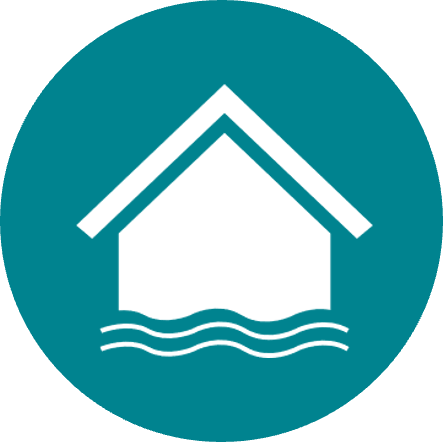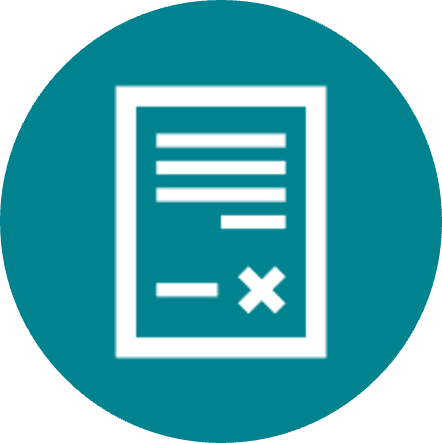
If you have received a letter (sample letter) from the Henrico County Department of Public Works informing you that your parcel is partially or entirely mapped within the FEMA Special Flood Hazard Area (SFHA), this page will help you understand the next steps for protecting you and your property. The updated maps will go into effect on April 25, 2024 for flood insurance purposes and are already being used for regulatory purposes.
What Are High-Risk Areas and the Special Flood Hazard Area (SFHA)?
In Henrico County, high-risk flood areas are identified as the SFHA, which consist of both FEMA SFHAs and Community SFHAs. These areas are often described as floodplains or areas located in a “100-year flood zone.” The term “100-year flood” can be misleading. It is more accurately described as the flood elevation that has a 1% chance of being equaled or exceeded each year. It is not the flood that will occur once every 100 years. There’s no way to predict when the next flood will occur— or the one after that.
High Risk flood zone designations are labeled as AE and A Zone on the maps. Regulatory requirements apply for all development in these areas, and flood insurance is mandatory for homeowners with a federally regulated mortgage. There’s a 26% chance that flooding will occur in a high-risk flood area over the life of a 30-year mortgage. Visit the County’s Map Viewer here to view the current and new maps.
What if my home or business is shown in a high-risk area, but I believe the designation is in error?
If you think your property has been incorrectly mapped in a high-risk area, you may submit a request to FEMA for a Letter of Map Change (LOMC). A LOMC reflects an official revision/amendment to an effective Flood Insurance Rate Map (FIRM). If the LOMC request is granted, you may be eligible for a lower flood insurance premium or the option to not purchase flood insurance. Technical data must be provided to support any claims that a property is incorrectly mapped, such as ground elevation data and/or revised flood studies. Click here to learn more about FEMA LOMCs.
Next Steps

I. Review Your New Building Requirements
All development in and adjacent to the SFHA must meet the requirements of the Henrico County Floodplain Ordinance (Henrico County Code Chapter 10, Article 1). Adjacent to the SFHA means that development is within 40 feet of the SFHA or within the 500-year floodplain.
Before you build, fill, or alter your land or the building on your property, you must obtain a Floodplain Permit to promote compliance with the County’s Floodplain Ordinance. The intent of the Floodplain Ordinance is to promote and protect health, safety, and general welfare of Henrico residents and to minimize flood losses. You should know:
- The placement of fill is prohibited within the SFHA.
- No new residential structures are permitted within the SFHA or within 15 feet of the SFHA, and existing residential structures in these areas may not be enlarged.
- New non-residential structures in the SFHA are required to have their lowest floor elevated at least two feet above the BFE. This additional elevation, or freeboard, is an extra measure of protection from flooding and could result in lower flood insurance premiums.
- All structures adjacent to the SFHA, meaning they’re within 40 feet of the SFHA or within the 500-year floodplain, must have their lowest floor elevated one foot above the BFE.
- Elevation Certificates showing the floor elevations are required for buildings in and adjacent to the SFHA.
- A No-Rise Certificate, signed and sealed by a registered Professional Engineer in VA, is required for all development in the SFHA to demonstrate it will not increase the flood elevation.

II. Understand Your Flood Insurance Options
If the new maps indicate a building on your property is newly added to the SFHA, you will be required by law to purchase a flood insurance policy if you carry a mortgage from a federally regulated or insured lender, once the maps go effective on April 25, 2024. If you do not have a mortgage, flood insurance is still strongly recommended, in part because most homeowners and renters insurance does not cover flood damage. If your property is in a high-risk area, it is even more important to protect yourself financially with flood insurance.
To help reduce the financial impact of the map change, the National Flood Insurance Program (NFIP) offers a newly mapped discount for the first year for buildings newly added to the SFHA. The premium then will gradually increase each year until it reaches its full-risk premium. If you purchase non-NFIP flood insurance from a private carrier, they may have different underwriting rules. Talk to your insurance agent for more details. More information can be found at Floodsmart.gov.
Flood insurance premiums are based on a number of factors, but there are some actions you may take to make flood insurance more affordable each year:
- Lower your flood risk. What you pay for NFIP flood insurance often has a lot to do with how much flood risk is associated with your property. Mitigating your flood risk not only protects your property against flood damage but can also help lower insurance costs. Visit floodsmart.gov for more details.
- Provide an elevation certificate. While not required when purchasing a policy, it may help your insurance agent get you a better rate.
- Choose a higher deductible. Choosing a higher deductible will lower your premium, but it means you will need to cover more of the cost to rebuild out of pocket. Increasing the deductible on your flood insurance policy to the $10,000 maximum could reduce your annual premium by up to 40 percent. Keep in mind, using the maximum deductible might not be appropriate or allowable for everyone.
Renting or Leasing?
If you are leasing a home or business on a parcel that is located in the SFHA, keep in mind that while your landlord may have flood insurance to cover their building, that insurance will not cover your personal belongings. Only a separate flood insurance policy can cover items damaged in a flood. Protect yourself with a flood insurance contents coverage policy. Your insurance agent can help you acquire a policy and answer questions.

III. Take Steps to Protect Your Property
In addition to flood insurance, there are measures you can take to protect your property.
- Install flood vents in the foundation walls of the building to help protect the structure from flood damage by reducing the pressure from flood waters
- Elevate air-conditioning units and furnaces or create a shield to divert water to protect your utilities or appliances from flooding. Efforts such as these will not only protect the equipment in a flood, they may also provide a discount on flood insurance.
- Maintain proper water runoff and drainage. Routinely clean and maintain gutters, downspouts, and splashpads so that rainwater from your roof flows easily away from your home. Also, make sure that any nearby drainage ditches or storm drains are clear of debris and functioning properly.
- Improve lot grading. Determine how water flows or accumulates around your home to identify potential trouble spots (often easy to see during an average rainstorm). Stormwater should always drain away from the building; if necessary, change your landscaping to improve runoff. This may include building up any sunken areas around the foundation, digging small depressions to properly channel water, and otherwise improving the yard so that it slopes away from your home.

IV. Understand Requirements for Future Improvements to Your Property
If your house or business is in the high-risk zone and you want to build an addition or otherwise improve it, you must start by applying for a Floodplain Development Permit. This promotes compliance with floodplain development requirements and helps avoid costly mistakes. Existing residential structures in the SFHA cannot be enlarged, but other improvements may be permitted, such as internal renovations. Non-residential structures may be enlarged if all applicable code requirements can be met.
For all buildings being improved, the value of the improvement (modification, alteration, repair, reconstruction, etc.) may not equal or exceed 50% of the market value of the existing structure. Improvements valued at less than 50% may not increase the nonconformity of the structure.
Additions and/or other improvements valued at 50% or more of the market value of the existing structure are considered substantial improvements. In such cases, the entire structure must be brought into compliance with the current Floodplain Ordinance and Building Code requirements.

Henrico Help Desk
Learn More
- Henrico County Map Updates Frequently Asked Questions (translations available)
- FloodSmart.gov: General information about flood insurance
- Map Changes & Flood Insurance: What Property Owners Need to Know
- National Flood Insurance Program (NFIP)
Key Terms
Base Flood Elevation (BFE) is the height (above sea level) that floodwaters are estimated to reach or exceed in a flood event with at least a 1% chance of occurring in any given year, also known as the SFHA or 100-year floodplain.
Development – Any man-made change to improved or unimproved real estate.
Freeboard – An added margin of safety, expressed in feet above a specific flood elevation, usually the BFE. Henrico County has adopted a 2-foot freeboard requirement within the SFHA and a 1-foot freeboard requirement in areas adjacent to the SFHA.
Abbreviations
BFE – Base Flood Elevation
FEMA – Federal Emergency Management Agency
FIRM – Flood Insurance Rate Map
LOMA – Letter of Map Amendment
LOMC – Letter of Map Change
NFIP – National Flood Insurance Program
SFHA – Special Flood Hazard Area




